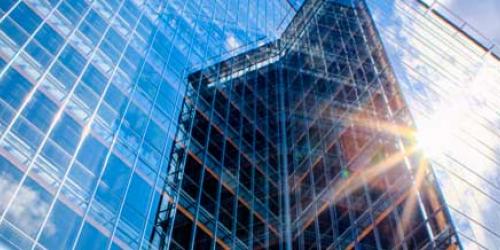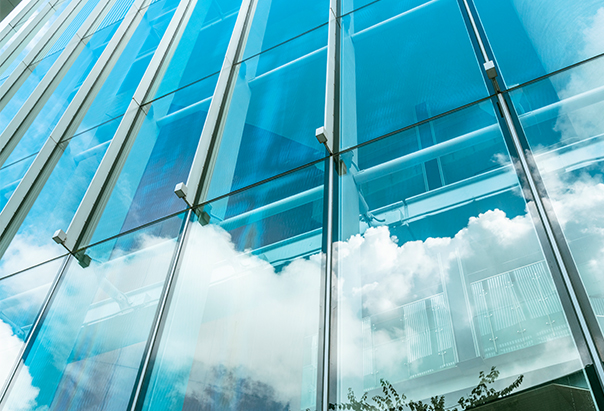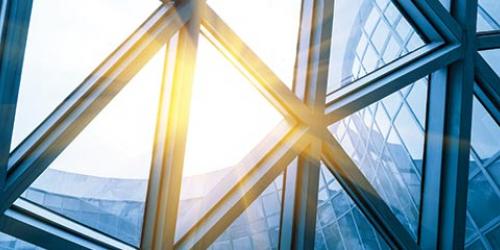Saflex® Solar interlayers and how they apply to the glass
Saflex® Solar interlayers are high-visible light transmittance, infrared (IR) radiation-absorbing interlayers designed to enhance solar heat gain performance in laminated glass compared to monolithic clear glass and laminates made with conventional polyvinyl butyral (PVB) interlayers. They have the capability to meet or exceed many regulations for laminated safety glazing when properly selected, laminated, and installed. The ideal solar product eliminates ultraviolet (UV) and near infrared (NIR) energy while allowing as much visible light transmittance as possible. Saflex Solar has the transmittance of a highly effective, high-visible, light transmittance solar product. Two options are available in the Saflex Solar range. Saflex Solar SG is our highest-performing Solar PVB interlayer. Saflex Solar SH has a more color-neutral appearance and may be laminated with annealed glass in some applications. Considerations to be made in the process of choosing either Saflex Solar SG or Saflex Solar SH were outlined in a recent newsletter item.
In some situations, thicknesses other than those produced for Saflex Solar (0.76 mm) may be needed for certain applications. In addition, it may be desired to combine the functionality of Saflex Solar with the functionality of other Saflex or Vanceva interlayers. The most common combinations, also referred to as stacks, are listed in Table 4. It is recommended that no more than four layers of interlayer be placed between two panes of glass to allow for proper processing under standard conditions. In this contribution, the use of clear glass without glass-coating products or other elements such as prints or frits is assumed.
Saflex Solar and Saflex Clear
Saflex Solar can be combined with Saflex Clear (RB) to meet specific impact requirements or to accommodate deviations in flatness in toughened or heat-strengthened glass. In this combination, the capacity of Saflex Solar to selectively absorb solar radiation is not affected. An example is provided in Table 1.
Table 1. Typical key performance characteristics of Saflex Solar stacked with Saflex Clear laminated with 4-mm clear glass
| Interlayer 1 | Interlayer 2 | Total interlayer thickness | Visible light transmittance* (%) | g-value* | Color rendering index * | Typical EN 356 impact classification |
| Saflex Clear | None | 0.76 mm | 88 | 0.80 | 99 | P2A |
| Saflex Solar SH | None | 0.76 mm | 83 | 0.63 | 96 | P2A |
| Saflex Solar SG | None | 0.76 mm | 75 | 0.53 | 93 | P2A |
| Saflex Clear | Saflex Clear | 1.52 mm | 87 | 0.78 | 99 | P4A |
| Saflex Solar SH | Saflex Clear | 1.52 mm | 82 | 0.62 | 96 | P4A |
| Saflex Solar SG | Saflex Clear | 1.52 mm | 75 | 0.52 | 93 | P4A |
*As calculated to EN 410
The light and solar characteristics of the Saflex Solar configurations are only slightly affected by the addition of a layer of Saflex Clear, but a significant change in typical impact classification is achieved.
An example of a combination of Saflex Solar and Saflex Clear is the Galeries Lafayette dome in Paris, France. After more than two years of extensive restoration, the glass dome at Galeries Lafayette’s flagship department store on Boulevard Haussmann was completed in May 2021. As the department store is among Paris’s main attractions—drawing in 37 million visitors annually—all restoration work was completed at night under the guidance of Perrot & Richard Architects, a Parisian firm specializing in historical building renovation including the Grand Palais. That project was completed in the early 2000s and features overhead glazing made of laminated glass with 20K m² of Saflex Clear PVB interlayer.
For the Galeries Lafayette dome’s restoration, solar control and transparency were top priorities. The exterior envelope protects the original stained glass cupola, so a transparent protective glazing with excellent clarity was required. The renovation team had a choice of three or four products, including Saflex Solar SG41 and SH41. Saflex Solar SH41 was chosen for its balanced combination of solar performance and neutrality while maintaining the safety benefits of laminated glass.
The Galeries Lafayette dome was built in 1912 and features art nouveau stained glass panels in the form of a flower. The 10 oversized sections stretch over a total of 1000 m² in rich tones of gold, red, and blue interspersed with clear panels featuring ornate ironwork. The original design was a collaborative effort by Ferdinand Chanut, who was responsible for the geometry and structure; Jacques Grüber, who created the beautiful stained glass; and Louis Majorelle, who fashioned the intricate ironwork.
Untouched for more than a century while the rest of the store received expansions such as floor additions, electrical work, and plumbing, it was time to give attention to the dome. One of the main focuses was to restore more of the natural light entering the dome that was lost due to the expansions. Extensive waterproofing was another requirement as well as solar protection. Finally, programmable lighting and motorized hoisting points were installed for staging events.
The new overhead glazing consists of flat glass made by Dania, France, and curved glass. For the flat panes, facade manufacturer Mtechbuild, France, used 44.4 tempered glass laminated with Saflex Solar SH41 interlayer. For the curved panes, 66.4 tempered glass laminated with Saflex Solar SH41 interlayer was used. The clear PVB interlayer was recommended by C.E.VIT glass consultant because it will provide years of protection for the dome’s interior stained glass masterpiece. While other options were presented, the use of Saflex Solar SH41 provides a pure light and improved solar performance.
The Galeries Lafayette spans 70,000 m² (750,000 sq ft) over eight open levels. While the dome can be viewed from numerous locations, perhaps the most breathtaking view is from the middle of the ground floor, staring up into the dazzling glass cupola. Now with a protective exterior facade with solar control and extremely fine clarity, the true colors of the dome can be enjoyed for years!
Saflex Solar and Saflex Acoustic (QS)
Saflex Solar can be combined with Saflex Acoustic (QS) to enhance not only the solar but also the acoustic performance of a laminated glazing. The performance of Saflex Acoustic QS is maintained in making this combination, as illustrated in Table 2.
Table 2. Typical performance characteristics of Saflex Solar stacked with Saflex Acoustic laminated with 4-mm clear glass
| Interlayer 1 | Interlayer 2 | Total interlayer thickness | STC*/Rw*** |
| Saflex Acoustic | None | 0.76 mm | 37 |
| Saflex Solar SH | None | 0.76 mm | 35 |
| Saflex Solar SG | None | 0.76 mm | 35 |
| Saflex Acoustic | None | 1.52 mm | 37 |
| Saflex Solar SH | Saflex Acoustic | 1.52 mm | 37 |
| Saflex Solar SG | Saflex Acoustic | 1.52 mm | 37 |
*As calculated to ASTM E413
**As calculated to ISO 717
As Saflex Acoustic is also a clear interlayer, the light and solar characteristics of this interlayer or its combination with Saflex Solar correspond to those listed in Table 1 for Saflex Clear, so the capacity of Saflex Solar to selectively absorb solar radiation is not affected in such combination.
Saflex Solar and Saflex Structural (DG)
Saflex Solar can be combined with Saflex Structural (DG) to provide a higher stiffness interlayer than is provided by Saflex Solar alone. The applicable modulus values for structural glass design are different from either Saflex Solar or Saflex Structural in isolation, as illustrated in Table 3 for a few selected stacks and load scenarios. A complete set of data can be obtained from your Eastman Saflex technical representative or by request on the website. The capacity of Saflex Solar to selectively absorb solar radiation in an interlayer combination of this type is not affected.
Table 3. Shear relaxation modulus values G(t) of Saflex Solar stacked with Saflex Structural for selected load scenarios
| Interlayer 1 | Interlayer 2 | Interlayer 3 | Total interlayer thickness | G(t), MPa | ||
| 3 s, 20°C |
30 s, 30°C | 5 min, 30°C | ||||
| Saflex Solar SH/SG | None | None | 0.76 mm | 11 | 0.7 | 0.5 |
| Saflex Solar SH/SG | Saflex Structural | None | 1.52 mm | 78 | 1.8 | 0.7 |
| Saflex Structural | Saflex Solar SH/SG | Saflex Structural | 2.28 mm | 120 | 3.2 | 1.0 |
| Saflex Structural | None | None | 0.76 mm | 135 | 11 | 2.4 |
An example of the combination of Saflex Solar and Saflex Structural is Cube Berlin in Berlin, Germany.
Located on the busy Washingtonplatz next to Berlin’s Central Station, the cleverly sculpted Cube Berlin is in the heart of the city’s business, government, and cultural district. With its prominent location, 3XN Architects of Copenhagen designed Cube Berlin to be a showstopping sculpture on the square. The all-glass design presented multiple challenges, including energy concerns and structural requirements. A collaborative team that included the architects, owners, coatings experts, glass manufacturer, PVB experts, and facade consultants worked to resolve potential concerns.
The solution was a pioneering, double-skin facade that uses coatings and PVB interlayers in a unique combination. To address the building owner’s strict energy requirements, Guardian Glass and Eastman selected, tested, and used reflective solar coatings on the outer skin of the building while adding a Saflex Solar SG/absorbing PVB interlayer to control solar heat gain in the cavity. Normally, these products are used on the inner skin. In essence, the team created a solar-absorbing, solar-reflecting effect in a single laminate.
Through expert knowledge and rigorous testing and modeling, the team recognized the impact of merging structural and solar PVB technologies. The novel approach of dual technologies was approved by Zulassung im Einzelfall (ZiE), a national standards board. Their close collaboration on this project has provided Guardian Glass and Eastman with a stronger partnership that will continue with other projects.
"To design such a complex product, you need real teamwork, which is exactly what happened during the design phase with the glass supplier, the PVB supplier, the architect, and the facade consultant all working closely together," says Joachim Fauth of Drees & Sommer, facade consultant on the project.
Such creative technology and architectural beauty benefit many. Occupants of the cube are treated to floor-to-ceiling views while enjoying a comfortable yet highly energy-efficient space. Passersby are treated to ever-changing reflections in the angled facade. And for students of architectural glass, the building will serve as a case study of innovation for years.
Saflex Solar and Vanceva Color or Vanceva Earth Tone
Saflex Solar can be combined with Vanceva Color or Vanceva Earth Tone interlayers. The aspect of such combinations should be carefully considered as the Saflex Solar products have a slight blueish hue that changes the original aspect of the Vanceva Color or Vanceva Earth Tone used. This effect is more pronounced for Saflex Solar SG as compared to Saflex Solar SH. The final laminate should be evaluated for aesthetic acceptability, as glazing and glazing components, lighting, viewing angle, and viewing distance can all have an effect of the appearance of a glazing. In addition, the visible light and radiation characteristics should be evaluated for the combination of these interlayers as both Saflex Solar and Vanceva Colors or Vanceva Earth Tone interlayers affect these characteristics. An example is provided in Table 4 for popular combinations of Saflex Solar and Vanceva Ocean Grey or Vanceva Earth Tone Shale (RB17 6544). In this table, a total interlayer thickness of 1.52 mm is achieved by the addition of Saflex Clear to avoid differences due to total interlayer thickness alone.
Table 4. Key optical/spectral characteristics of selected grey Vanceva colors and Saflex Solar combinations laminated with 4 mm clear glass.
| Interlayer 1 | Interlayer 2 | Interlayer 3 | Total interlayer thickness | Property* | ||
| VLT (%) | g-value | CRI | ||||
| Vanceva Ocean Grey (VCV 000H) | Saflex Clear 0.76 mm | Saflex Clear 0.38 mm | 1.52 mm | 62 | 0.67 | 97 |
| Vanceva Ocean Grey (VCV 000H) | Saflex Solar SH | Saflex Clear 0.38 mm | 1.52 mm | 58 | 0.53 | 94 |
| Vanceva Ocean Grey (VCV 000H) | Saflex Solar SG | Saflex Clear 0.38 mm | 1.52 mm | 53 | 0.44 | 90 |
| Vanceva Earth Tone Shale (RB17 6544) | Saflex Clear 0.76 mm | Saflex Clear 0.38 mm | 1.52 mm | 44 | 0.59 | 96 |
| Vanceva Earth Tone Shale (RB17 6544) | Saflex Solar SH | Saflex Clear 0.38 mm | 1.52 mm | 42 | 0.47 | 94 |
| Vanceva Earth Tone Shale (RB17 6544) | Saflex Solar SG | Saflex Clear 0.38 mm | 1.52 mm | 38 | 0.39 | 91 |
*As calculated to EN 410
Use the combined functionality of Saflex Solar and other interlayers in your next project. Contact your Eastman representative for a discussion on feasibility and benefits of any of the combinations described.










